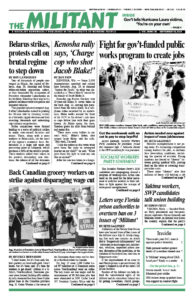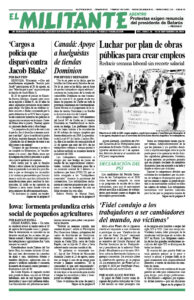Tens of thousands of people converged in Minsk, the capital of Belarus, Aug. 30, chanting and flying white-red-white opposition colors, as they demanded the resignation of President Alexander Lukashenko on his birthday. Blocking their way to his palatial residence were riot police and armored vehicles.
This popular upheaval erupted Aug. 9 after Lukashenko moved to prolong his 26-year rule by claiming victory in a blatantly rigged election and then arresting thousands and unleashing cop violence on protesters.
Strike committees were formed leading to a wave of political strikes in major state-owned factories and mines. These, along with a mass walkout at Belaruskali, hit the heart of the regime’s economic base. Belaruskali is a huge salt mine and processing plant in Soligorsk, which produces a fifth of the world’s potash. These workers added their voices to the protests demanding new elections, the release of all the detainees and prosecution of those responsible for the killing and torture of Lukashenko’s opponents.
On Aug. 31, Anatoly Bokun, leader of the Belaruskali strike committee, was detained by police. Committee spokesperson Glab Sandras said that state secret police, with the Soviet-era name KGB, “have inundated the factory, tracking the most active workers.” They are also trying to “blackmail workers with [threats of] mass dismissals.”
In a video recorded by Belaruskali miners, they offer testimonies: “I am on strike because I am against violence in any form. I am on strike because I cannot look at mothers whose children were killed by the regime. I am on strike because I want to be respected all over the world. I am on strike because I want the workers to receive decent wages. I am on strike because I want my vote to be reckoned with.”
“Stop working for the dictator and the regime!” the miners say, calling on fellow workers to join the fight.
The red and white colors of the former national flag, adopted by the protest movement, have mushroomed everywhere, hanging off apartment complexes, at factories, schools and offices. Solidarity rallies by supporters of the Belarusian battle have spread to Lithuania and Ukraine, from New York to London. Even the largest Russian trade union federation, loyal to Moscow, protested the violent crackdown against Belarusian workers.
In Minsk, weekly Sunday protests have reached a quarter million people in a city of two million. The population of Belarus is 9.5 million.
Protests and strikes have spread throughout the country, reaching 55 different cities and towns. Several thousand women marched in the capital Aug. 29, with smaller rallies in other cities.
On Aug. 26, a large procession of workers from the Belarusian Automobile Plant and their supporters marched in Zhodzina. They chanted “Lukashenko to the police wagon!”, “Leave!” and “Long live Belarus!”
A council of opposition figures is calling for a peaceful transition of power and new elections. The government refuses to talk to the group and has arrested some on criminal charges.
At the mines and other workplaces, strike leaders responded by organizing workers who didn’t yet feel comfortable with walking out, into work-to-rule and slowing down production.
Lukashenko threatened the striking Soligorsk miners that he could easily bring in replacement labor from Ukraine. Mykhailo Volynets, chair of the Independent Trade Union of Miners of Ukraine, responded via a video address to fellow miners in Belarus that Ukrainian miners would never be used as strikebreakers.
Regime looks to help from Moscow
Lukashenko has received cautious backing from Russian President Vladimir Putin, who formed a special police reserve for possible intervention in Belarus. Putin said the two leaders “agreed not to use it until the situation starts spinning out of control.”
Since the implosion of the Soviet Union in the early 1990s, the new Russian capitalist rulers have tried to keep control over adjoining and newly independent former Soviet republics. At times this has led to bloody Russian intervention, as in Georgia in 2008 and after working people in Ukraine rose up in 2014 and overthrew the pro-Moscow government of Viktor Yanukovych.
Today the regime of Vladimir Putin in Moscow sees Belarus as a bulwark against the expansion of U.S.-led NATO forces into eastern Europe. Lukashenko claims the NATO powers are trying to make Belarus “a bridgehead against Russia,” and he has ordered troops to the western border.
The prospect of a democratic movement toppling the autocratic government in Belarus gravely concerns the regime in Moscow. Putin has called for the government and opposition there to find a way out of the crisis.
Putin also has his own problems. In the city of Khabarovsk, in Russia’s far east, there have been weekly rallies by thousands since the July 9 arrest of popular regional Gov. Sergei Furgal. Some protesters have started carrying signs of solidarity with the Belarus protests.
Belarus has longstanding cultural, language and economic bonds with Russia, but an intervention by Moscow would risk turning the sentiment of working people in the country against the Russian government and cause a surge in solidarity protests around the world, not the least in Russia itself.

